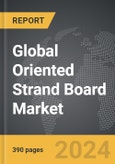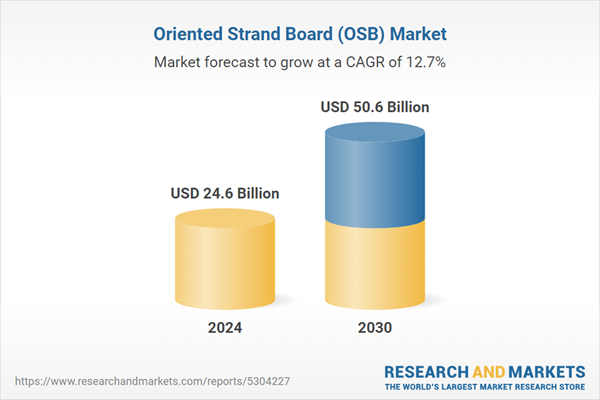Global Oriented Strand Board (OSB) Market - Key Trends & Drivers Summarized
Oriented Strand Board (OSB) is a type of engineered wood product made from thin wood strands that are oriented in specific directions and bonded together with adhesives under heat and pressure. OSB is widely used in construction for sheathing in walls, floors, and roofs due to its strength, durability, and cost-effectiveness. The manufacturing process involves layering strands of wood in cross-oriented patterns, which gives OSB its impressive structural properties. This makes it a popular choice for load-bearing applications in both residential and commercial buildings.The use of OSB has grown significantly due to its advantages over traditional plywood. It offers better uniformity, resistance to warping, and a lower cost, which makes it an attractive option for builders and contractors. OSB can be produced from a variety of wood species, including aspen, poplar, and southern yellow pine, making it a versatile and sustainable building material. Furthermore, advancements in adhesive technology and manufacturing processes have improved the moisture resistance and overall performance of OSB, expanding its applications in different climatic conditions.
The growth in the Oriented Strand Board (OSB) market is driven by several factors. Firstly, the increasing demand for cost-effective and sustainable building materials in the construction industry is a major driver. Secondly, advancements in manufacturing technologies are enhancing the strength, durability, and moisture resistance of OSB, making it suitable for a wider range of applications. Thirdly, the rising trend of prefabricated and modular construction is boosting the demand for OSB due to its ease of use and adaptability. Additionally, the growing emphasis on green building practices and the use of renewable resources are promoting the adoption of OSB. Furthermore, the recovery of the housing market and increased construction activities in emerging economies are creating new growth opportunities for OSB manufacturers. Lastly, supportive government policies and incentives for sustainable construction materials are further driving the growth of the OSB market.
Report Scope
The report analyzes the Oriented Strand Board (OSB) market, presented in terms of market value (USD). The analysis covers the key segments and geographic regions outlined below.- Segments: Grade (OSB / 1, OSB / 2, OSB / 3, OSB / 4); Application (Construction, Packaging, Furniture, Other Applications).
- Geographic Regions/Countries: World; USA; Canada; Japan; China; Europe; France; Germany; Italy; UK; Spain; Russia; Rest of Europe; Asia-Pacific; Australia; India; South Korea; Rest of Asia-Pacific; Latin America; Argentina; Brazil; Mexico; Rest of Latin America; Middle East; Iran; Israel; Saudi Arabia; UAE; Rest of Middle East; Africa.
Key Insights:
- Market Growth: Understand the significant growth trajectory of the OSB / 1 Grade segment, which is expected to reach US$19.3 Billion by 2030 with a CAGR of 10.8%. The OSB / 2 Grade segment is also set to grow at 12.5% CAGR over the analysis period.
- Regional Analysis: Gain insights into the U.S. market, valued at $7.5 Billion in 2024, and China, forecasted to grow at an impressive 17.6% CAGR to reach $11 Billion by 2030. Discover growth trends in other key regions, including Japan, Canada, Germany, and the Asia-Pacific.
Why You Should Buy This Report:
- Detailed Market Analysis: Access a thorough analysis of the Global Oriented Strand Board (OSB) Market, covering all major geographic regions and market segments.
- Competitive Insights: Get an overview of the competitive landscape, including the market presence of major players across different geographies.
- Future Trends and Drivers: Understand the key trends and drivers shaping the future of the Global Oriented Strand Board (OSB) Market.
- Actionable Insights: Benefit from actionable insights that can help you identify new revenue opportunities and make strategic business decisions.
Key Questions Answered:
- How is the Global Oriented Strand Board (OSB) Market expected to evolve by 2030?
- What are the main drivers and restraints affecting the market?
- Which market segments will grow the most over the forecast period?
- How will market shares for different regions and segments change by 2030?
- Who are the leading players in the market, and what are their prospects?
Report Features:
- Comprehensive Market Data: Independent analysis of annual sales and market forecasts in US$ Million from 2024 to 2030.
- In-Depth Regional Analysis: Detailed insights into key markets, including the U.S., China, Japan, Canada, Europe, Asia-Pacific, Latin America, Middle East, and Africa.
- Company Profiles: Coverage of players such as Arbec Forest Products Inc., Coillte, EGGER Group, Georgia-Pacific LLC, Huber Engineered Woods LLC. and more.
- Complimentary Updates: Receive free report updates for one year to keep you informed of the latest market developments.
Some of the 59 companies featured in this Oriented Strand Board (OSB) market report include:
- Arbec Forest Products Inc.
- Coillte
- EGGER Group
- Georgia-Pacific LLC
- Huber Engineered Woods LLC.
- Kronoplus Limited
- SWISS KRONO AG
- Louisiana-Pacific Corporation
- RoyOMartin Lumber Company
- Sonae Arauco
- Tolko Industries Ltd.
- West Fraser
- Weyerhaeuser Company
This edition integrates the latest global trade and economic shifts into comprehensive market analysis. Key updates include:
- Tariff and Trade Impact: Insights into global tariff negotiations across 180+ countries, with analysis of supply chain turbulence, sourcing disruptions, and geographic realignment. Special focus on 2025 as a pivotal year for trade tensions, including updated perspectives on the Trump-era tariffs.
- Adjusted Forecasts and Analytics: Revised global and regional market forecasts through 2030, incorporating tariff effects, economic uncertainty, and structural changes in globalization. Includes historical analysis from 2015 to 2023.
- Strategic Market Dynamics: Evaluation of revised market prospects, regional outlooks, and key economic indicators such as population and urbanization trends.
- Innovation & Technology Trends: Latest developments in product and process innovation, emerging technologies, and key industry drivers shaping the competitive landscape.
- Competitive Intelligence: Updated global market share estimates for 2025, competitive positioning of major players (Strong/Active/Niche/Trivial), and refined focus on leading global brands and core players.
- Expert Insight & Commentary: Strategic analysis from economists, trade experts, and domain specialists to contextualize market shifts and identify emerging opportunities.
Table of Contents
Companies Mentioned (Partial List)
A selection of companies mentioned in this report includes, but is not limited to:
- Arbec Forest Products Inc.
- Coillte
- EGGER Group
- Georgia-Pacific LLC
- Huber Engineered Woods LLC.
- Kronoplus Limited
- SWISS KRONO AG
- Louisiana-Pacific Corporation
- RoyOMartin Lumber Company
- Sonae Arauco
- Tolko Industries Ltd.
- West Fraser
- Weyerhaeuser Company
Table Information
| Report Attribute | Details |
|---|---|
| No. of Pages | 302 |
| Published | January 2026 |
| Forecast Period | 2024 - 2030 |
| Estimated Market Value ( USD | $ 24.6 Billion |
| Forecasted Market Value ( USD | $ 50.6 Billion |
| Compound Annual Growth Rate | 12.7% |
| Regions Covered | Global |









